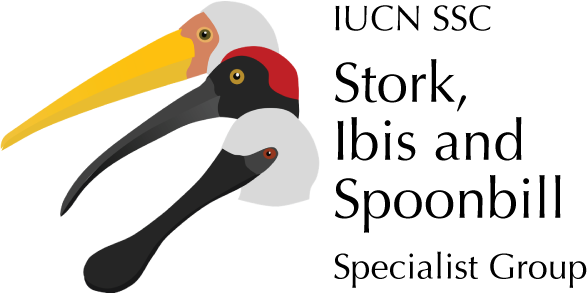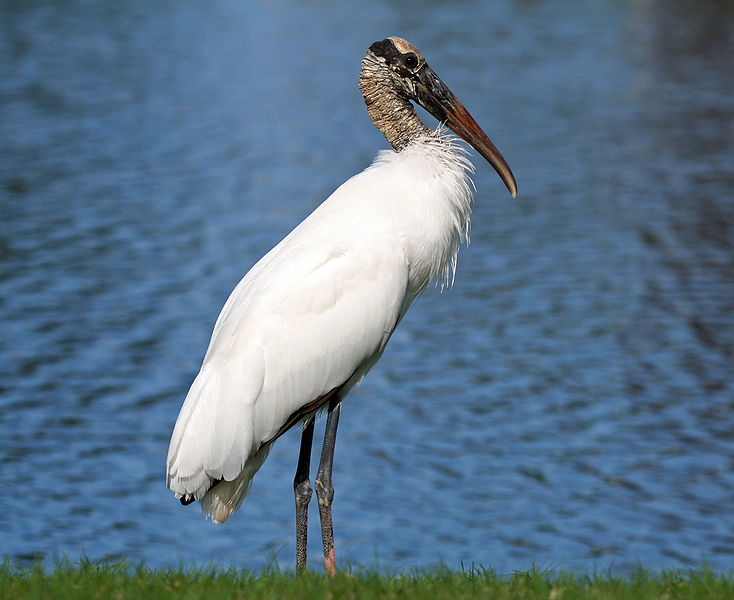Wood Stork
IUCN Red List category

SOURCE:
Wikipedia, the free encyclopedia
Description
The wood stork’s head much resembles that of an ibis
Wood stork in flight at Harris Neck National Wildlife Refuge
The adult is a large bird which stands 83 to 115 cm (33–45 in) tall and spans 140 to 180 cm (55–71 in) across the wings. Males typically weigh 2.5 to 3.3 kg (5.5–7.3 lb), with a mean weight of 2.7 kg (6.0 lb); females weigh 2.0 to 2.8 kg (4.4–6.2 lb), with a mean weight of 2.42 kg (5.3 lb).[4][5] Another mean estimated weight for the species was 2.64 kg (5.8 lb).[6] However, exceptionally large males are sometimes found and these can weigh up to 4.5 kg (9.9 lb).[7] It appears all white on the ground, with blackish-gray legs and pink feet. In flight, the trailing edge of the wings is black. The head is dark brown with a bald, black face, and the thick down-curved bill is dusky yellow. Juvenile birds are a duller version of the adult, generally browner on the neck, and with a paler bill. The bare head and the long bill, which can measure up to 25.5 cm (10.0 in) in length, render the wood stork distinctive from other large waders in its range.[8]The standard scientific measurements of the wood stork are as follows: the wing is 42–49 cm (17–19 in), the culmen is 19–25 cm (7.5–9.8 in) and the tarsus is 17.5–21.5 cm (6.9–8.5 in).[9]
Habitat and breeding
This is a subtropical and tropical species which breeds in much of South America, Central America and the Caribbean. The wood stork is the only stork that presently breeds in North America. In the United States there is a small breeding population in Florida, Georgia, and South Carolina, along with a recently discovered rookery in southeastern North Carolina. After a successful three-decade conservation effort resulting in an increased population in the southeastern United States, the wood stork was removed from the endangered species list and upgraded to threatened on June 26, 2014.[3] Similarly, in the state of Santa Catarina, Brazil, its decline seems to have been reversed: after an absence between the late 1960s and the mid-1990s, the species is now again regularly encountered there, in particular in the Tubarão River region.[10] It is likely that the Paraná River region’s wetlands served as a stronghold of the species, from where it is now re-colonizing some of its former haunts.[11] Globally, it is considered a species of Least Concern by the IUCN due to its large range.[1]
The wood stork is a broad-winged soaring bird that flies with its neck outstretched and legs extended. It forages usually where lowering water levels concentrate fish in open wetlands; it also frequents paddy fields. Walking slowly and steadily in shallow water up to its belly, it seeks prey, which, like that of most of its relatives, consists of fish, frogs and large insects. It catches fish by holding its bill open in the water until a fish is detected.[12]
In the United States, the wood stork favors cypress trees in marshes, swamps, or (less often) among mangroves and nearby habitat.[13]
A resident breeder in lowland wetlands with trees, the wood stork builds a large stick nest in a forest tree. They nest colonially with up to twenty-five nests in one tree.[13] Breeding once a year, a female typically lays three to five eggs in the clutch. The eggs are incubated 27–32 days by both sexes. Wood storks’ reproductive cycle is triggered when waterholes dry up sufficiently to concentrate fish in sufficient numbers for efficient feeding of the chicks. Each chick weighs approximately 2 oz (57 g), is unable to fly and is helpless. Competition for food is fierce, and if food is scarce, only the older chicks will survive. Week-old chicks are fed about 15 times per day, and grow rapidly. By 14 days, each will weigh 10 times its hatching weight. At 28 days, each is 25 times heavier. During the breeding season, wood storks need over 400 lb (180 kg) of fish to feed themselves and their offspring. When the weather is very warm, parents also collect water and bring it to the nest to drool on and into the mouths of the chicks. By the time the young are four weeks old, both parents leave the nest to search for food, and this continues until the chicks fledge or leave the nest. Young may continue to return to the colony for another 10 to 15 days to roost or to try to get food from their parents. A colony is considered successful if its parents average at least 1.5 fledged young per nest.[14]
Each adult will defend its nest against various predators. Corvids, vultures, grackles and striped skunks will attempt to pick off eggs.[14] Raccoons are the leading predator of nests, and can cause almost complete colony nesting failure when water dries under nests in drought years since they can easily access the nest using dry ground under the tree.[15] Adults have few natural predators, but unwary ones have been picked off by American alligators.[16]
Evolution
Wood stork alighting, Hontoon Dead River, in Florida
This species seems to have evolved in tropical regions; its North American presence probably postdates the last ice age. A fossil fragment from the Touro Passo Formation found at Arroio Touro Passo (Rio Grande do Sul, Brazil) might be of the living species; it is at most from the Late Pleistoceneage, a few 10,000s of years ago.[17] North American fossils from that time are of an extinct larger relative, M. wetmorei. This was probably a sister species; both occurred sympatrically on Cuba at the end of the Pleistocene.[18]
References
- ^ Jump up to: a b BirdLife International (2012). “Mycteria americana“. IUCN Red List of Threatened Species. Version 2013.2. International Union for Conservation of Nature. Retrieved 26 November 2013.
- Jump up ^ “Wood stork (Mycteria americana) Species Profile”. U.S. Fish & Wildlife Service Environmental Conservation Online System. U.S. Fish & Wildlife Service. 31 August 2014.
- ^ Jump up to: a b “Wood stork off endangered list after recovery in U.S. Southeast”. Reuters. 26 June 2014. Retrieved 1 July 2014.
- Jump up ^ “Potential risk to wood storks (Mycteria americana) from mercury in Carolina Bay fish”. Environmental Pollution 120: 405–413. 2002-02-05. doi:10.1016/s0269-7491(02)00112-4.
- Jump up ^ CRC Handbook of Avian Body Masses, 2nd Edition by John B. Dunning Jr. (Editor). CRC Press (2008). ISBN 978-1-4200-6444-5.
- Jump up ^ Palmer, R. S. (1962). Handbook of North American birds, Volume 1, Loons through Flamingos. Yale Univ. Press, New Haven, CT.
- Jump up ^ “Wood Stork (Mycteria americana)”. Pelotes Island Nature Preserve. 1997-01-02. Retrieved 2013-01-30.
- Jump up ^ “Everglades National Park (Page 2)”. ParkVision: Images of America’s National Parks. Retrieved 2013-01-30.
- Jump up ^ Hancock, James A.; Kushlan, James A.; Kahl, M. Philip (1992). Storks, Ibises, and Spoonbills of the World. Academic Press. ISBN 978-0-12-322730-0.
- Jump up ^ Amorim, James Faraco; Piacentini, Vítor de Queiroz (2006). “Novos registros de aves raras em Santa Catarina, Sul do Brasil, incluindo os primeiros registros documentados de algumas espécies para o Estado” [New records of rare birds, and first reports of some species, in the state of Santa Catarina, southern Brazil] (PDF). Revista Brasileira de Ornitologia (in Portuguese and English) 14(2): 145–149. Electronic supplement
- Jump up ^ Bencke, Glayson Ariel (22 June 2007). Avifauna atual do Rio Grande do Sul, Brasil: aspectos biogeográficos e distribucionais [The Recent avifauna of Rio Grande do Sul: Biogeographical and distributional aspects] (PDF) (Speech) (in Portuguese). Quaternário do RS: integrando conhecimento, Canoas, Rio Grande do Sul, Brazil.
- Jump up ^ Sibley, David Allen (2003). The Sibley Field Guide to Birds of Eastern North America. New York: Alfred A. Knopf. p. 58. ISBN 0-679-45120-X.
- ^ Jump up to: a b Ehrlich, Paul R.; Dobkin, David S.; Wheye, Darryl (1992). Birds in Jeopardy. Stanford, CA: Stanford University Press. p. 18. ISBN 0-8047-1967-5.
- ^ Jump up to: a b “Bio Facts: Wood Stork”. Jacksonville Zoo and Gardens. Archived from the original on 12 May 2008. External link in
|website=(help) - Jump up ^ “Wood Stork — Behavior — Birds of North America Online”. Bna.birds.cornell.edu. Retrieved 2013-01-30.
- Jump up ^ Carroll, Sean (21 January 2004). “ADW: Mycteria americana: Information”. Animal Diversity Web. University of Michigan Museum of Zoology. Retrieved 30 January 2013. External link in
|website=(help) - Jump up ^ Schmaltz Hsou, Annie (20 June 2007). O estado atual do registro fóssil de répteis e aves no Pleistoceno do Estado do Rio Grande do Sul, Brasil [The current state of the fossil record of Pleistocene reptiles and birds of Rio Grande do Sul] (PDF) (Speech) (in Portuguese). Quaternário do RS: integrando conhecimento, Canoas, Rio Grande do Sul, Brazil.
- Jump up ^ Suarez, William; Olson, Storrs L. (2003). “New Records of Storks (Ciconiidae) from Quaternary Asphalt Deposits in Cuba” (PDF). Condor 105 (1): 150–154. doi:10.1650/0010-5422(2003)105[150:NROSCF]2.0.CO;2.
Further reading
- Alsop, Fred J. III (2002). Birds of Texas. New York City: DK Publishing, Inc. ISBN 0-7894-8388-2.
External links
| Wikimedia Commons has media related to Mycteria americana. |
| Wikispecies has information related to: Mycteria americana |
- Wood Stork Species Account – Cornell Lab of Ornithology
- Wood stork – Mycteria americana – USGS Patuxent Bird Identification InfoCenter
- Florida Bird Sounds at Florida Museum of Natural History
- Wood stork videos, photos, and sounds at the Internet Bird Collection
- Wood stork photo gallery at VIREO (Drexel University)
- Wood stork species account at NeotropicalBirds (Cornell University)





